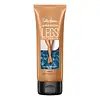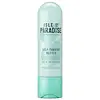What's inside
What's inside
 Key Ingredients
Key Ingredients

 Benefits
Benefits

 Concerns
Concerns

 Ingredients Side-by-side
Ingredients Side-by-side

Water
Skin ConditioningCyclopentasiloxane
EmollientTalc
AbrasivePEG/PPG-18/18 Dimethicone
EmulsifyingTribehenin
EmollientDipropylene Glycol
HumectantBis-PEG/PPG-14/14 Dimethicone
EmollientDimethicone
EmollientPropylene Glycol
HumectantPhenoxyethanol
PreservativePanthenol
Skin ConditioningSilica Silylate
EmollientCaprylyl Glycol
EmollientSodium Chloride
MaskingDisteardimonium Hectorite
StabilisingGluconolactone
Skin ConditioningDimethicone Crosspolymer
Emulsion StabilisingTocopheryl Acetate
AntioxidantHdi/Trimethylol Hexyllactone Crosspolymer
Salvia Officinalis Leaf Extract
CleansingSalvia Officinalis Oil
MaskingPropylene Carbonate
SolventSorbic Acid
PreservativeGlycerin
HumectantSodium Benzoate
MaskingCyclohexasiloxane
EmollientSilica
AbrasiveCalcium Gluconate
HumectantMagnesium Ascorbyl Phosphate
AntioxidantPalmaria Palmata Extract
Skin ProtectingIron Oxides
CI 77891
Cosmetic ColorantMica
Cosmetic ColorantWater, Cyclopentasiloxane, Talc, PEG/PPG-18/18 Dimethicone, Tribehenin, Dipropylene Glycol, Bis-PEG/PPG-14/14 Dimethicone, Dimethicone, Propylene Glycol, Phenoxyethanol, Panthenol, Silica Silylate, Caprylyl Glycol, Sodium Chloride, Disteardimonium Hectorite, Gluconolactone, Dimethicone Crosspolymer, Tocopheryl Acetate, Hdi/Trimethylol Hexyllactone Crosspolymer, Salvia Officinalis Leaf Extract, Salvia Officinalis Oil, Propylene Carbonate, Sorbic Acid, Glycerin, Sodium Benzoate, Cyclohexasiloxane, Silica, Calcium Gluconate, Magnesium Ascorbyl Phosphate, Palmaria Palmata Extract, Iron Oxides, CI 77891, Mica
Water
Skin ConditioningDihydroxyacetone
Skin ConditioningDimethicone
EmollientCyclopentasiloxane
EmollientCetearyl Alcohol
EmollientC12-15 Alkyl Benzoate
AntimicrobialCaprylic/Capric Triglyceride
MaskingCyclohexasiloxane
EmollientGlyceryl Stearate
EmollientIsopropyl Myristate
EmollientPEG-100 Stearate
Magnesium Aluminum Silicate
AbsorbentErythrulose
TanningCI 77891
Cosmetic ColorantTocopheryl Acetate
AntioxidantAgastache Mexicana Flower/Leaf/Stem Extract
Skin ConditioningAloe Barbadensis Extract
Skin ConditioningAscorbic Acid
AntioxidantCitrus Grandis Peel Oil
MaskingCocos Nucifera Oil
MaskingMica
Cosmetic ColorantEucalyptus Globulus Leaf Oil
PerfumingMentha Piperita Oil
MaskingPanthenol
Skin ConditioningPersea Gratissima Oil
Skin ConditioningSalvia Hispanica Seed Oil
MoisturisingSalvia Officinalis Oil
MaskingTropaeolum Majus Flower/Leaf/Stem Extract
Skin ConditioningPropanediol
SolventPropylene Glycol
HumectantGlycerin
HumectantParfum
MaskingBenzophenone-4
UV AbsorberEthylhexylglycerin
Skin ConditioningLactic Acid
BufferingPEG-40 Hydrogenated Castor Oil
EmulsifyingLinalool
PerfumingMethoxyphenyl T-Butylphenyl Propanediol
Skin ConditioningPhenoxyethanol
PreservativeTriethylene Glycol
MaskingCI 16035
Cosmetic ColorantCI 19140
Cosmetic ColorantWater, Dihydroxyacetone, Dimethicone, Cyclopentasiloxane, Cetearyl Alcohol, C12-15 Alkyl Benzoate, Caprylic/Capric Triglyceride, Cyclohexasiloxane, Glyceryl Stearate, Isopropyl Myristate, PEG-100 Stearate, Magnesium Aluminum Silicate, Erythrulose, CI 77891, Tocopheryl Acetate, Agastache Mexicana Flower/Leaf/Stem Extract, Aloe Barbadensis Extract, Ascorbic Acid, Citrus Grandis Peel Oil, Cocos Nucifera Oil, Mica, Eucalyptus Globulus Leaf Oil, Mentha Piperita Oil, Panthenol, Persea Gratissima Oil, Salvia Hispanica Seed Oil, Salvia Officinalis Oil, Tropaeolum Majus Flower/Leaf/Stem Extract, Propanediol, Propylene Glycol, Glycerin, Parfum, Benzophenone-4, Ethylhexylglycerin, Lactic Acid, PEG-40 Hydrogenated Castor Oil, Linalool, Methoxyphenyl T-Butylphenyl Propanediol, Phenoxyethanol, Triethylene Glycol, CI 16035, CI 19140
Ingredients Explained
These ingredients are found in both products.
Ingredients higher up in an ingredient list are typically present in a larger amount.
Ci 77891 is a white pigment from Titanium dioxide. It is naturally found in minerals such as rutile and ilmenite.
It's main function is to add a white color to cosmetics. It can also be mixed with other colors to create different shades.
Ci 77891 is commonly found in sunscreens due to its ability to block UV rays.
Learn more about CI 77891Cyclohexasiloxane is a type of silicone more commonly known as D6. It is an emollient and solvent.
Cyclohexasiloxane is used to evenly distribute ingredients throughout the product. When applied to the skin, Cyclohexasiloxane evaporates and leaves behind a silky feel.
As an emollient, it can help the skin feel soft and hydrated. It is also used to reduce frizz in hair products.
Learn more about CyclohexasiloxaneCyclopentasiloxane, or D5, is a silicone used to improve texture of products and trap moisture.
D5 is considered lightweight and volatile. Volatile means it evaporates quickly after application. Once evaporated, D5 leaves a thin barrier that helps keep skin hydrated.
It is also an emollient. Emollients help soften the skin and prevent water loss. Silicones create a silky texture in products. D5 helps other ingredients become more spreadable.
Studies show D5 is safe to use in skincare products. We recommend speaking with a skincare professional if you have concerns.
Learn more about CyclopentasiloxaneDimethicone is a type of synthetic silicone created from natural materials such as quartz.
What it does:
Dimethicone comes in different viscosities:
Depending on the viscosity, dimethicone has different properties.
Ingredients lists don't always show which type is used, so we recommend reaching out to the brand if you have questions about the viscosity.
This ingredient is unlikely to cause irritation because it does not get absorbed into skin. However, people with silicone allergies should be careful about using this ingredient.
Note: Dimethicone may contribute to pilling. This is because it is not oil or water soluble, so pilling may occur when layered with products. When mixed with heavy oils in a formula, the outcome is also quite greasy.
Learn more about DimethiconeGlycerin is already naturally found in your skin. It helps moisturize and protect your skin.
A study from 2016 found glycerin to be more effective as a humectant than AHAs and hyaluronic acid.
As a humectant, it helps the skin stay hydrated by pulling moisture to your skin. The low molecular weight of glycerin allows it to pull moisture into the deeper layers of your skin.
Hydrated skin improves your skin barrier; Your skin barrier helps protect against irritants and bacteria.
Glycerin has also been found to have antimicrobial and antiviral properties. Due to these properties, glycerin is often used in wound and burn treatments.
In cosmetics, glycerin is usually derived from plants such as soybean or palm. However, it can also be sourced from animals, such as tallow or animal fat.
This ingredient is organic, colorless, odorless, and non-toxic.
Glycerin is the name for this ingredient in American English. British English uses Glycerol/Glycerine.
Learn more about GlycerinMica is a naturally occurring mineral used to add shimmer and color in cosmetics. It can also help improve the texture of a product or give it an opaque, white/silver color.
Serecite is the name for very fine but ragged grains of mica.
This ingredient is often coated with metal oxides like titanium dioxide. Trace amounts of heavy metals may be found in mica, but these metals are not harmful in our personal products.
Mica has been used since prehistoric times throughout the world. Ancient Egyptian, Indian, Greek, Roman, Aztec, and Chinese civilizations have used mica.
Learn more about MicaPanthenol is a common ingredient that helps hydrate and soothe the skin. It is found naturally in our skin and hair.
There are two forms of panthenol: D and L.
D-panthenol is also known as dexpanthenol. Most cosmetics use dexpanthenol or a mixture of D and L-panthenol.
Panthenol is famous due to its ability to go deeper into the skin's layers. Using this ingredient has numerous pros (and no cons):
Like hyaluronic acid, panthenol is a humectant. Humectants are able to bind and hold large amounts of water to keep skin hydrated.
This ingredient works well for wound healing. It works by increasing tissue in the wound and helps close open wounds.
Once oxidized, panthenol converts to pantothenic acid. Panthothenic acid is found in all living cells.
This ingredient is also referred to as pro-vitamin B5.
Learn more about PanthenolPhenoxyethanol is a preservative that has germicide, antimicrobial, and aromatic properties. Studies show that phenoxyethanol can prevent microbial growth. By itself, it has a scent that is similar to that of a rose.
It's often used in formulations along with Caprylyl Glycol to preserve the shelf life of products.
Propylene Glycol is an odorless, colorless liquid. As a humectant, it helps skin retain moisture. It also aids in delivering active ingredients.
Another role of this ingredient is preventing a product from melting or freezing. Propylene glycol also adds antimicrobrial properties to a product, elongating product lifespan.
This ingredient is considered an organic alcohol and commonly added into both cosmetics and foods.
Those with sensitive skin or conditions may develop a rash when using this ingredient.
Learn more about Propylene GlycolSalvia Officinalis Oil is an oil.
Tocopheryl Acetate is AKA Vitamin E. It is an antioxidant and protects your skin from free radicals. Free radicals damage the skin by breaking down collagen.
One study found using Tocopheryl Acetate with Vitamin C decreased the number of sunburned cells.
Tocopheryl Acetate is commonly found in both skincare and dietary supplements.
Learn more about Tocopheryl AcetateWater. It's the most common cosmetic ingredient of all. You'll usually see it at the top of ingredient lists, meaning that it makes up the largest part of the product.
So why is it so popular? Water most often acts as a solvent - this means that it helps dissolve other ingredients into the formulation.
You'll also recognize water as that liquid we all need to stay alive. If you see this, drink a glass of water. Stay hydrated!
Learn more about Water